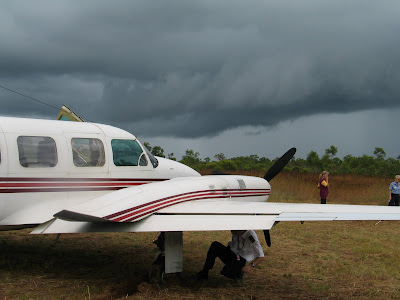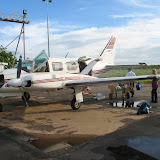Sunday, April 01, 2007
Kandiwal

Another Wet Season storm rumbled in the distance, the sky darkened ominously, and the smell of imminent rain came on the wind. Looking at the landing gear half buried on the runway, I wished I had thrown a spare set of underwear in my pack, because it looked like we might be here for awhile.
 It had been a pretty long week. I'd begun by flying to Perth for the quarterly Medical Coordinators meeting. All 18 site coordinators met with the staff of the Rural Clinical School, and our Head, Campbell Murdoch to review this year's progress to date, plan for upcoming assessments, and deal with concerns and issues. The meetings took two days, but required 4 days of my time, there being no way to get from Derby to Perth either in time for a morning meeting, or on the flip side, home after a 3pm adjournment. The trip involves driving the 220 km from Derby to Perth, then logging 4400 kilometers of air travel from Broome to Perth and back, finally driving back to Derby. My plane home on Wednesday was delayed 4 hours in Perth, so I didn't arrive in Broome until after 4 pm. This is what led to my "Close Encounter of the Bovine Kind", (as Dr. Atkinson called it). And the week was only just begun.
It had been a pretty long week. I'd begun by flying to Perth for the quarterly Medical Coordinators meeting. All 18 site coordinators met with the staff of the Rural Clinical School, and our Head, Campbell Murdoch to review this year's progress to date, plan for upcoming assessments, and deal with concerns and issues. The meetings took two days, but required 4 days of my time, there being no way to get from Derby to Perth either in time for a morning meeting, or on the flip side, home after a 3pm adjournment. The trip involves driving the 220 km from Derby to Perth, then logging 4400 kilometers of air travel from Broome to Perth and back, finally driving back to Derby. My plane home on Wednesday was delayed 4 hours in Perth, so I didn't arrive in Broome until after 4 pm. This is what led to my "Close Encounter of the Bovine Kind", (as Dr. Atkinson called it). And the week was only just begun. 
Friday I was due to fly to Kandiwal for a remote clinic, having been scrubbed the week before. This Aboriginal community is 350 Km north of Derby. The indigenous people who originally lived in this are from the Wunambal language group. They lived on the Mitchell Plateau of the Kimberly from time immemorial, but were removed in 1942 (due to fears of Japanese invasion) to the Kunmunya Mission, and finally to the Mowanjum community, located 10 Km outside of Derby. In the 1980s many Aboriginal people moved back from relocation sites to their ancestral lands. Kandiwal is a community that resulted from such a return to the land. There is a nearby airstrip, built by a mining company that has prospecting rights to aluminum deposits in the area. The Aboriginal people have been trying to reclaim their land rights to the entire area for many years, and are concerned about the impacts of proposed mining, tourism, and other activities upon their ancestral home.

We got up early and were at the airport at 0630 AM. The medical flights to Kandiwal are organized by the Royal Flying Doctor Service, which provided our flight nurse, Gail. DAHS provides the Aboriginal Health worker, Shelly and the doctor, me. Gail had all the medical equipment packed. Because the site is so remote, she brings a flying pharmacy, all kinds of bandages, a cold Esky for vaccines and medicines, and all the medical equipment we need including baby and adult scales for weights. The Kandiwal community has only a small number of adults and a large number of kids, so we packed everything needed for child health checks and sick kid visits. Gail has been a flight nurse for a long time, and was completely organized when Shelly and I arrived with the charts. I only had to bring my medical bag and a backpack with lunch. Truly "no worries".
The flight up was smooth, and I spent the time watching the land and sea slip by below. The flight path went north over the Kimberly coast, which has to be one of the last true wildernesses left on Earth. There are no roads into the area, and the tidal rips and whirlpools are said to be the worst on the planet. For an hour and a half we flew over mudflats, mountains, and scrub plateaus lacking any signs of human impact. The geography is unique- some of the oldest rocks on the planet, over 1.3 billion years old, worn and weathered to flats, and nubbins of hills, and remnants of mountains. The community car met us at the field and took us the 5 Km to the community. We spent a busy morning and early afternoon seeing patients and handing out balloons to the kids. Then we packed up, and returned to the airfield, reloaded and taxied to the end of the runway, where the plane suddenly stopped and lurched to the right. Our embarrassed pilot shut down the props and we trooped out to examine the problem. A quick try at pushing the plane out of the mud was futile, and our hosts had already left the airfield. The pilot and I decided that perhaps we could dig a ramp forward out of the hole and drive the plane out of trouble. The field was mostly gravel, and we seemed to have found the one soft spot on the entire runway. He found the nosewheel pullbar, and I walked out into the bush and found a large tree branch, which we used to dig and scrape away the mud in front of the wheel. Then with the plane unloaded of the 3 of us passengers, and the rain minutes away, the pilot revved the engines to full power, released the brake, and slowly, centimeter by centimeter the wheel moved up the ramp and we were free. We piled back into the aircraft, and as we shut the doors, the rain pounded onto the aluminum skin. The pilot gunned the engines, we shot down the runway and out from beneath the storm, and I vowed to at least bring a toothbrush, if not a shovel, on my next remote clinic flight.
For larger, detailed views, click ON THE PICTURES in the blog above. For more photos, click this picture below:
 |
| Kandiwal Trip |
